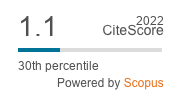Fog water supply possibilities in the Antofagasta in the Antofagasta Region, Chile.
Keywords:
Water supply, fog water, water shortage, Atacama Desert, AntofagastaAbstract
An analysis has been made of the possibiluies for supplying potable water to Mejilllones, Paposo and Taltal by collecting fog water. The deficiencies in the current water supplies to these tocalities are documented. The geographical conditions which make possible the collectlon of water using large fog collectors are listed and a brief theoretical approach has been given in regard to the three terrain features. This analysis was done using maps and in situ studies of the terrain. lt is specifically recommended that a system of fog collection be implemented the fishing village of Paposo becacause of the favorable geographical conditions and the precarious state of the present water supply.
Downloads
References
CERECEDA, P., 1989: Proyecto Camanchaca-Chile. IDRC. Informe Final Instituto de Geografía, Pontificia Universidad Católica de Chile.
CERECEDA, P. Y SCHEMENAUER, R.S. 1991: The occurrence of fog in Chile. J. Appl. Meteor., 3D, 10971105.
CERECEDA, P., SCHEMENAUER, R.S. y SUIT, M. 1992: An altemative water Supply for Chilean coastal desert villages. Water Resources Development, vol.8 Nº 1, 5359.
ESPINOSA, C., 1977: El atrapanieblas 611115. Boletín Universidad Católica del Norte, Antofagasta , Chile.
FUENZALIDA, H.A., RUTLLAND,J. YVERGARA,J. 1989: meteorological aspects of water collection from stratocumuli in northem Chile. 3rd. Intl. Conf.Onsouthem Hemis. Meteor. & Oceanography, Buenos Aires, Argentina, 13-17 nov ., 1156-161.
HSU, S.A., 1973: West coast winds, South América. Coastal Studies Bulletin, N" 7, Coastal Studies Inst ., Louisiana Univ., pp. 20.
NIEMEYER, H. YCERECEDA, P. 1984: Hidrografía. Colección Geografía de Chile, Tomo VIII, Instituto Geográfico Militar, Santiago, Chile.
SCHEMENAUER, R.S., FUENZALIDA, H. y CERECEDA, P. 1988: A neglected water resource: the Camanchaca of Souih America. Bull. Amer. Meteor. Soc., 69, 138147.
SCHEMENAUER, R.S. y CERECEDA, P. 1991: Fog water collection in arid coastallocations. Ambio. 20. Nº 7, 303-308.
SCHEMENAUER, R.S. y CERECEDA, P. 1992: Water from fog covered mountains. Waterlines, 1O, 10-13.
SCHEMENAUER, R.S. y CERECEDA, P. 1992a: The quality of fog water collected for domestic and agricullural use in Chile. Journal of Applied Meteorology, 31, Nº 3, 275-290. VALENCIA, R., 1992: Posibilidad del uso de la camanchaca para abastecer de agua potable algunas localidades de la Segunda Región. Memoria para obtener el título de geógrafo. Pontificia Universidad Católica de Chile. Santiago, Chile.
ZULETA, R., 1980: Veinte años de camanchaca y dos del proyecto Mejillones. Universidad Católica del Norte, Antofagasta, Chile.






